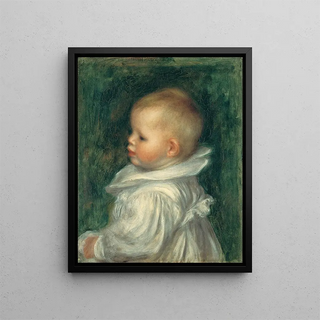Art print | Portrait of Claude Renoir - Pierre-Auguste Renoir


View from behind

Frame (optional)
Portrait of Claude Renoir - Pierre-Auguste Renoir – Captivating Introduction
In the fascinating world of art, some works transcend the mere frame to become witnesses of an era, reflections of emotions, and gateways to personal stories. The "Portrait of Claude Renoir" by Pierre-Auguste Renoir is one of those iconic pieces that capture not only the essence of the subject but also the vibrant spirit of the Impressionist movement. This portrait, depicting the artist's son, is a celebration of parental tenderness and the fleeting beauty of childhood. Through this masterpiece, Renoir invites us to immerse ourselves in a moment of tenderness, where light and color blend to create a warm and intimate atmosphere.
Style and uniqueness of the work
Renoir's style is immediately recognizable, characterized by fluid brushstrokes and bold use of color. In the "Portrait of Claude Renoir," the artist manages to capture the liveliness and innocence of his son through a luminous palette. Warm hues, ranging from golden yellows to vibrant reds, blend harmoniously to evoke joy and the lightness of childhood. The blurred background, typical of Impressionism, highlights the main subject while creating a dreamy ambiance. This stylistic choice is not limited to a simple realistic representation but is part of an artistic approach aimed at conveying emotion, a state of mind. By observing Claude's sparkling gaze, the viewer is transported to a world where time seems suspended, where every detail matters, revealing the depth of family bonds.
The artist and his influence
Pierre-Auguste Renoir, an emblematic figure of the Impressionist movement, mastered, throughout his career, redefining art standards by emphasizing light, color, and movement. His innovative approach influenced not only his contemporaries but also left an indelible mark on future generations of artists. The "Portrait of Claude Renoir" perfectly illustrates this quest for beauty and truth. Through his works, Renoir sought to immortalize moments of life, fleeting emotions,

Matte finish

View from behind

Frame (optional)
Portrait of Claude Renoir - Pierre-Auguste Renoir – Captivating Introduction
In the fascinating world of art, some works transcend the mere frame to become witnesses of an era, reflections of emotions, and gateways to personal stories. The "Portrait of Claude Renoir" by Pierre-Auguste Renoir is one of those iconic pieces that capture not only the essence of the subject but also the vibrant spirit of the Impressionist movement. This portrait, depicting the artist's son, is a celebration of parental tenderness and the fleeting beauty of childhood. Through this masterpiece, Renoir invites us to immerse ourselves in a moment of tenderness, where light and color blend to create a warm and intimate atmosphere.
Style and uniqueness of the work
Renoir's style is immediately recognizable, characterized by fluid brushstrokes and bold use of color. In the "Portrait of Claude Renoir," the artist manages to capture the liveliness and innocence of his son through a luminous palette. Warm hues, ranging from golden yellows to vibrant reds, blend harmoniously to evoke joy and the lightness of childhood. The blurred background, typical of Impressionism, highlights the main subject while creating a dreamy ambiance. This stylistic choice is not limited to a simple realistic representation but is part of an artistic approach aimed at conveying emotion, a state of mind. By observing Claude's sparkling gaze, the viewer is transported to a world where time seems suspended, where every detail matters, revealing the depth of family bonds.
The artist and his influence
Pierre-Auguste Renoir, an emblematic figure of the Impressionist movement, mastered, throughout his career, redefining art standards by emphasizing light, color, and movement. His innovative approach influenced not only his contemporaries but also left an indelible mark on future generations of artists. The "Portrait of Claude Renoir" perfectly illustrates this quest for beauty and truth. Through his works, Renoir sought to immortalize moments of life, fleeting emotions,






